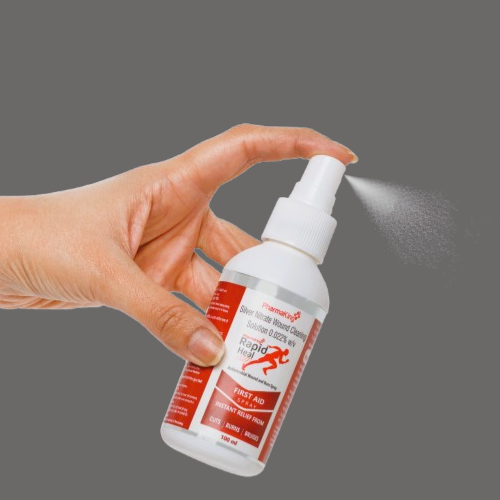How Rapid Heal Works?
PharmaKing Rapid Heal Spray is a clear, odorless and transparent topical use spray containing Silver Nitrate. It is an antimicrobial Skin and Wound Cleanser intended for use under the supervision of a healthcare professional for the cleansing of foreign materials including micro-organisms from wounds such as stage I-IV pressure ulcers, diabetic foot ulcers, post-surgical wounds, first and second-degree burns, grafted and donor sites. It helps in the mechanical removal of debris and foreign material from the wound site. It is least toxic to the tissues, non – irritating & non-staining & soothes pain through its cooling effect. It contains active silver ions which are continuously released (140 ppm) and these are dispersed through the water base from nano to colloidal and micro particles.
Mechanism of Action:
PharmaKing Rapid Heal Antimicrobial Wound and Burn spray is a clear, isotonic liquid that helps in the mechanical removal of the debris and foreign material from the application site. Dirt, debris and foreign materials are mechanically removed by the action of the fluid (Wound Cleanser) moving across the wound bed or application site. PharmaKing Rapid Heal antimicrobial Skin and it inhibits the growth of bacteria such as Staphlyococcus aureus, Psuedomonas aeruginosa, Escherichia coli, Proteus mirabilis, Serratia marcescens, Clostridium difficile, including antibiotic resistant Methicillin Resista nt Staphylococcus aureus (MRSA), Vancomycin Resistant Enterococcus faecalis(VRE), Carbapenem Resistant E.coli (CRE) and Acinetobacter baumannii, that are commonly found in wound bed as well as fungi such as Candida albicans and Aspergillus niger.
As a metal, Silver is relatively inert. However, in the presence of wound fluids or other secretions, it readily ionizes and becomes highly reactive in binding to proteins and cell membranes. Similar to other heavy metals, Silver is toxic to microorganisms by poisoning respiratory enzymes and components of the microbial electron transport system as well as impairing some DNA function Metallic Silver ionizes in the presence of moisture, body fluids, and secretions to release the biologically active AB’ which shows a strong affinity for sulphydryl groups and other anionic ligands of proteins, cell membranes, and tissue debris. It provides moisture to wound bed and also assists in wound debridement.
Ag+ bind protein residues on celi membrazes of sensitive bacteria, fungi and protozoa, and is absorbed Intracellularly by pinocytosis. Subsequent denaturation and inactivation of proteins and essential enzymes including RNA- and DNA-ases forms the basis of the genetically regulated Anti-microbial action of Silver. Silver- sensitive strains of bacteria and fungi have been shown to absorb and concentrate Ag’ from dilute solutions (1ppm) by an oligodynamic action. When absorbed by bacteria or yeast cells, the silver ion absorbed by bacteria or yeast cells, the silver ion (Ag”) is lethal in sensitive strains.
Silver may be absorbed via the gastrointestinal tract, lungs, mucous membranes, and skin lesions. Clinical studies with antibiotic wound dressings have shown that most of the Ag’ released into the wound bed is deposited superficially and that minimal levels are available for absorption.
The clinical and experimental studies indicate that percutaneous absorption of Silver is exceedingly low. Epidermal keratin and phospholipids of the epidermal barrier function provide effective barriers with exposed sulphydryl groups irreversibly binding free AG+ in much the same way as other metallic elements.
